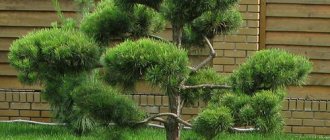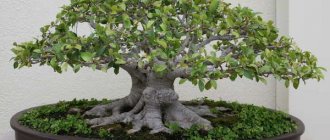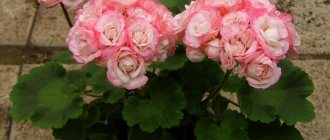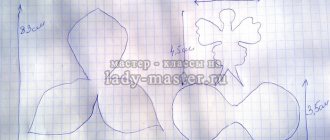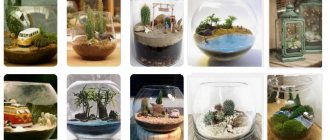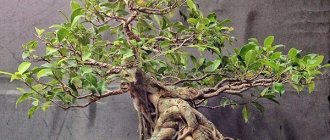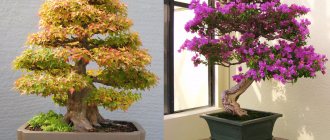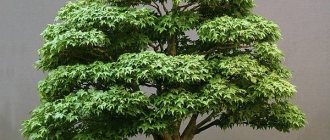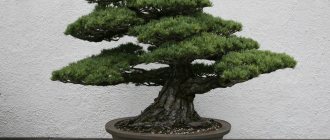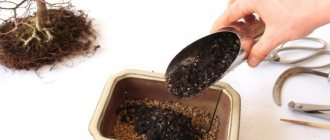Making bonsai with your own hands
You can create a mini-copy of natural wood yourself at home. To achieve the desired effect, you need to know certain growing features. To do this you will need to prepare:
- pot;
- priming;
- materials and tools for planting.
Azalea bonsai
The plant requires long-term and careful care. But, if you make all the necessary efforts, this natural creation will become a real highlight in the interior.
Preparation of material for growing
Selecting seeds or planting material for germination
The process of growing bonsai at home can take several years. First of all, you need to germinate the seeds. Then the owner of the plant needs to carefully take care of the seedlings. And only then will it be possible to form a tree.
It is not always possible to grow bonsai from seeds the first time. If you plan to grow a decorative mini-tree on the balcony, it is recommended to give preference to tropical species. These include:
- laurel;
- Korean lemon;
- dracaena;
- a coffee tree.
Beginners are recommended to try growing ficus bonsai. This is an unpretentious plant that does not require special care. You can also plant pine or fir, which grows very slowly, but turns into a beautiful tree.
Mini laurel tree
Choosing a pot for bonsai
Regardless of the type of plant you will use to grow your bonsai, the pot should be wide and shallow. Thanks to this, proper growth and development will be ensured. The owner of the plant will be able to properly control the branching of roots and form the crown. The right container should have large drainage holes. To prevent the soil from spilling out, you need to place a net on one of them. It is not allowed to have designs, beads, or seed beads on the inside of the pot. Plain colored containers are best.
Bonsai soil
Soil is of great importance for growing a decorative mini-tree. It should be soil enriched with nutrients that retains moisture well. It is recommended that the mix include:
- swamp clay, which ensures a uniform supply of nutrients; it is best to use clay granules;
- volcanic sand - it increases the porosity of the earth and oxygen permeability;
- river sand – retains moisture;
- humus is natural humus that accumulates and releases nutrients well;
- the last component is pumice, it absorbs nutrients and moisture well, and then distributes them throughout the plant. This component promotes the proper formation of roots and prevents them from growing deep inside the container.
Do I need to fertilize bonsai?
It is very important to properly care for the soil during bonsai growth. Since mini trees have a very branched root system, they need as many minerals as possible. Therefore, plants need additional feeding. The main fertilizers to be used are:
- nitrogen;
- phosphorus;
- potassium.
Feeding should be balanced and have a ratio of 12 units of nitrogen, 6 phosphorus and 6 potassium.
Note! It is possible to stimulate the growth of a mini-tree only with the ratio of all three elements (nitrogen, phosphorus, potassium), and not each of them separately!
How long does a bonsai grow?
There are two periods in the process of growing bonsai:
- For several years the owner has to care for the seeds.
- The second stage is the main one – growing and caring for the sprout.
In Japan, such trees have been grown for centuries, passed down from generation to generation. There are trees that are already about 4,000 years old. The most durable mini-trees are conifers.
Crown shapes for bonsai
There are many varieties of bonsai forms:
- formal and informal vertical;
- fan;
- semi-cascade and cascade;
- fallen or dead tree;
- double barrel
To learn how to properly shape a growing tree, you can attend specialized master classes.
Types of crowns
When to replant
Until the age of five, the plant must be replanted every year in the spring. The soil must be completely replaced. Once the plant is 10 years old, planned replanting becomes necessary only every 10-15 years.
After the procedure, the bonsai should not be placed in direct sunlight for two weeks.
Important! The need to replant may be necessary urgently when the roots of the tree begin to rot.
Bonsai Questions and Answers
History of Japanese BonsaiThe origins of Japanese bonsai itself (inseparable from the rich artistic traditions of the past) can be traced back to the creation of the work "Man'yoshu". Unfortunately, the paucity of materials makes research in this area difficult. The review below uses materials from the books “The Art of Bonsai” by Kobayashi Tadao (or Norme) and “Reflections on the History of Bonsai and Suiseki in Japan” by Ma-rushima Hideo. From ancient times to the present day, the Japanese have been distinguished by their love of nature. In Manyoshu there is a lot of poetic evidence of this feeling, often addressed to a single tree or blade of grass. Based on the evidence scattered throughout the anthology, one can judge the fairly high level of garden art of this period. The introduction at the beginning of the 7th century of the Taihoryo code, which regulated, among other things, land ownership and land use, contributed in particular to the development of plant care techniques. In the popular novel of the 10th century “Utsubo-monogatari” (“hollow tree”) or, according to Conrad N.I. , “The Tale of a Hollow” can be found as a statement of the aesthetic principles of garden art, which still serve as the basis for modern bonsai art. In general, however, there is a lack of specific information about bonsai during the Nara-Heian period (7I0-II92). The first written mention of bonsai itself dates back to the end of the Kamakura period (I192-1333). We are talking about the book “Kasuga Gongen kenki” (“Amazing stories about Kasuga Gongen” (1309), which tells about the history of the Buddhist temple Kasuga in the city of Na-ra from 937 to 1304. In one of the illustrations you can see an image composition of bonsai that meets the modern canons of this art. On the shelf there is a so-called "oekidai" ("fireplace stand"), which is a black lacquer dish with low sides. The bottom is covered with sand, natural "stones, a pine tree and a tree with pale pink flowers are installed . Nearby there is an "additional" herbal bonsai (probably Japanese calamus). The pine has the appearance of a "noble" old tree. Even further away, a stone is installed in a ceramic dish and grass is planted. Thus, during this period the basic principles of bonsai display were already developed. Images Bonsai can also be found in other books: "Honen Shonin" ("Life of Saint Honen"), "Ippen Shonin" ("Life of Saint Ippen") (1299). Bonsai was widespread - the action takes place in the historical province of Chikuzen on the island Kyushu. Bonsai received further development in the activities of the monks of the “five monasteries” of the Zen Buddhist sect Rinzai, who organically included the art of bonsai within the framework of Buddhist culture. Unfortunately, no images of their work have survived. However, a general idea of this can be obtained from the “gozan bungaku” or from the surviving book “The Garden of Nanzenji Temple. Thus, in a poem by one of Muso Kokushi’s students on the theme “Pine in a Bowl,” a majestic image of a pine tree grown in a pot is created, “and after thousands of years, in old age, the striking beauty of the green needles.” Speaking about the history of bonsai, it is impossible to ignore the book “Tsurezuregusa”. Here is an excerpt from it: “Once the same [Prince] Suketomo took refuge from the rain in the gates of the Eastern Temple. Many beggars gathered there with their arms and legs twisted, crooked or twisted. Seeing these people, he thought: “These are wonders, each of which has no equal. They deserve all our admiration." However, as the nobleman peered at the cripples, his interest in them disappeared, and he, suddenly feeling deep disgust, thought: “People should look ordinary, and not seem outlandish,” and went home. After that, he lost interest in both plantings, deciding: “In our time, out of love for garden trees, trying to twist and break branches in order to give them bizarre shapes and thus please your eyes is the same as having an addiction to admiring such cripples.” , and ordered to tear out and throw away all the trees planted in pots. And this is also a commendable act. The above lines are commented in two ways: either as rejection
aesthetically the principles of bonsai as such, or as a rejection of excessive sophistication of form in favor of “genuine” natural bonsai. One way or another, the above passage can be considered as a significant confirmation (even if of an “anti-bonsai” orientation) of the prevalence of bonsai in that period. Another literary source on the history of bonsai from the Ka-makura period is the yokyouku “Hachi no ki”. The hero of the play, sheltering a guest on a cold snowy night, without firewood to warm him, sacrifices his treasure - a bonsai tree - for kindling, thereby expressing the utmost degree of respect. Such an action is clear evidence of the awareness of the value of bonsai in that era. From the same play it follows that even in the provincial region of Kante, the houses of the nobility kept several pots of bonsai, using plants such as plum, cherry, pine, etc., and were well acquainted with the technical techniques of growing bonsai (correcting the shape of branches, thinning the crown and etc.). The exact time when the play was written is unknown, however, judging by the dates of the life of the yokyoku author, the play reflects the attitude towards the art of bonsai at the end of the Kamakura period and the beginning of the Muromachi period. “Bonsan totoku” (“Ten Commandments of Bonsan”). During the Kamakura and Muromachi periods (I192-1573), bonsai was widespread not only among the upper echelons of society, but also penetrated into the military class of the samurai. At the same time, this was the heyday of such traditional types of Japanese art as the tea ceremony, the art of incense “kodo”, Noh theater, the aesthetic principles of “sabi-wabi” (which have remained unchanged to this day in the art of bonsai), etc. The eighth was a big fan of the art of bonsai Muromachi period shogun Asjaga Yimasa. On May 7, 1463, by order of the shogun, all gozan monasteries were to submit their bonsai to him, and on May 25, a similar order was issued regarding monasteries not included in the gozan structure. Those who disobeyed were persecuted. From the works collected in this way, bonsai were selected that appealed to the shogun. Subsequently, they were cultivated everywhere. At the end of the Muromachi period, the so-called “Bonsan totoku” (“ten commandments of bonsans”) appeared, which were ten “five-character” maxims. Their approximate translation is as follows: 1) sensitive heart, pleasant appearance; 2) a never-sleeping eye 3) a pure soul that does not accept filth 4) the ability to recognize the age of seedlings 5) the ability to see the landscape up close 6) the ability to “enter” the grotto without moving 7) (“without searching”) the ability to see the seashore 8) to appreciate the evening cool in summer 9) remain unspoiled in old age (obviously, we are talking about the plant). “Bonsan” (“mountain on a tray”), judging by the name, includes the concept of bonsai and another bonsai concept - “suiseki”.
Bonsai from the Edo period (1603-1868)
The flourishing of bonsai during the Kamakura-Muromachi period temporarily stopped during the “era of war of kingdoms” - a period of internecine wars in the 21st century. Further, during the period of the Tokugawa shogunate (1603-1868), with the establishment of peace, bonsai gradually again took its former place in the cultural and everyday life of Japan. Almost all shoguns of the period favored the development of this art, especially the third shogun Iemitsu (I623-I65I). There are many stories about his hectic social life. His extensive collection of bonsai in the castle of the city of Edo (the residence of the Tokugawa shoguns) was constantly guarded by seven warriors. The shogun loved to show off her “daimyo” (according to N.I. Conrad - “senior”) and present his loved ones with some of these works. There is a popular story condemning Okubo Hikozaemon, who threw the shogun's favorite arrangement of five-leaf pine (probably a gift from the shogun) into the garden. It is believed that this work has been preserved and is now kept in the imperial palace. In 1681, the oldest Japanese manual on gardening art was published, which caused a whole stream of publications of similar books.
However, from the point of view of the art of bonsai, all of them are not of great value, and contain the simplest information such as growing seedlings in a pot. These books, however, testify to the extreme popularity of plums, cherries, and rhododendrons at that time. The onset of the reign of Genroku (I688-1704) is characterized by the rapid growth of luxury in the everyday life of wide sections of the urban population, including a passion for gardening art. This is evidenced, in particular, by numerous ukiyo-e. The peak of this hobby occurred in the first half of the 19th century. In the cities of the Edo period, one could constantly see bonsai traders carrying pots displayed on stretchers along the streets, and the sight of cramped gardens or verandas - engawa, lined with pots of flowers and herbs became a common sight. In 1812 and 1817 Two manuals on the extremely popular garden art were published in succession. Plants with spotted leaves, fashionable at that time, cost a lot of money. Thus, the price of a pot of rodea could reach up to 2 thousand ryo (about 100 million yen). However, such interest in curiosities, which often became the object of speculation, has nothing to do with the painstaking cultivation of “natural” bonsai. It would not be an exaggeration to say that bonsai was absent during this period of the Edo period. The revival of interest in authentic bonsai dates back to the end of the Tokugawa shogunate. At this time, the modern hieroglyphic spelling of the word bonsai appeared (however, it had the reading “hachiue” - “growing in a pot”) and replaced other options from all manuals. At the end of the Edo period, a major role in the development of the art of bonsai was played by the Kamigata literati (the adopted name uniting two cultural centers - Kyoto and Osaka) - Yori Sanyo, Tanomura Chikuden, Ike Taiga. Being fans of “nanga” (the so-called “painting of the southern school” of China), they transferred the principles of this school to bonsai, forming elegant compositions in the spirit of “nanga”. They often used their bonsai to decorate pavilions for (very fashionable at that time) tea ceremony. In their works, they followed the recommendations of the Chinese treatise “Kaishien Gaden” (“The Word on Painting from the Mustard Seed Garden”), sometimes called the “nanga” manual. Numerous terms (for example, the names of the styles “tokkan”, “kengai”, etc. ) from this manual, widely used in the "literati bonsai" entered the bonsai lexicon and is still used today. “Bonsai of the Literary” was further developed and reached a high artistic level in Edo, where the cultural and political center of the country gradually moved from Kamigata by the time of the Meiji reforms (1868). In the early years of the Meiji period (1868-1912), along with the accepted term "hachiue", the current reading "bonsai" of the hieroglyphic spelling of this word came into use.
The heyday of bonsai from the Meiji period to the present day
Since the early years of Meiji, interest in bonsai has been constantly growing. Collecting bonsai became a subject of rivalry among political leaders of the time. Bonsai was elevated to the category of art; by the second half of the Meiji period, a new term “bijutsu bonsai” appeared - “artistic bonsai”. In March 1892, the world's first bonsai exhibition, called the “Congress of Artistic Bonsai,” was opened in one of the restaurants in Tokyo (in the current Bunkyo district), at which works from 30 parks in Tokyo were presented. The reason for the emergence of the concept of “artistic bonsai” was not only the high appreciation of the art of bonsai, but also the need to separate two concepts - bonsai and “hachiue” (“growing in a pot”), the confusion of which occurred in the early Meiji years. Thus, the manual “Bonsai Shitate Hiho” (“Secrets of Growing Bonsai”), published in 1902, describes, among other things, growing plants such as lilies, morning glory, etc. in pots.
During the Taisho period (I9I2-I926), many publications appeared that paid special attention to the development of bonsai techniques. This time is characterized by a widespread desire (both among specialists and amateurs) to increase professionalism. An amateur “Society for the Promotion of Bonsai Development” is organized, monthly bonsai exhibitions are held (usually in restaurants), and the monthly magazine “Bonsai” begins to be published. The catastrophic earthquake in the Kanto region in 1923 caused great damage to the development of bonsai. At the same time, it was the reason for the founding, on the initiative of Tokyo bonsai artists, of the so-called Bonsai Village in the city of Omiya (Saitama Prefecture) | In October 1927, the first “public” (for mass access) bonsai exhibition was organized in the assembly hall of the Asahi newspaper publishing house. In 1928, a special equipped area was built in the area of Hibuya Park (Tokyo), where major exhibitions were held. Bonsai was used for the first time to celebrate Emperor Showa's accession to the throne. For this purpose, works were collected from all over the country: from the ministerial court to the most remote areas. One of the brochures of that time assessed bonsai as follows: “Bonsai expresses the beauty of nature, “hachiue” - the beauty of an ornamental plant. In 1930, the professional “Union of Tokyo Bonsai Artists” was created where specialists regularly exchanged experience and their works. Bonsai, which gained a strong position among other arts, received a high social status and recognition of the broad masses of the population after the “National Bonsai Exhibition” was held in March 1934 at the Tokyo Museum of Fine Arts, a place where government exhibitions of the all-Japan level were usually held and unique works were demonstrated art. The presence of the word “national” (literally in the style of our country) in the title of the exhibition indicates the awareness of bonsai as a specifically Japanese art form. These exhibitions have been held annually since then (except during wartime). They played an invaluable role in establishing the position of Japanese bonsai. The Second World War stopped the development of bonsai. The last pre-war “national exhibition” took place in 1942. At that time, one could hear the following opinion: “At such a time, it is unpatriotic to engage in bonsai; we should plant sweet potatoes on the available land, not bonsai.” However, the war ended, and with it the bonsai fell away. The war also had an unexpectedly positive impact on bonsai - soldiers of the garrison troops (the official name of the US occupation forces in Japan) and their families contributed to the spread of bonsai throughout the world among the widest segments of the population. National bonsai exhibitions were revived in 1947. In 1964. On the basis of the National Bonsai Society, a corporate legal entity was created - the Japanese Bonsai Association. Now there are almost 30 thousand bonsai lovers in the Association, the chairman is Kishi Nobusuke. As for the professionals represented by the Tokyo Bonsai Union, they transformed in 1969 into the Japan Bonsai Cooperation. Since 1976, the Cooperation, together with other organizations, has been holding the “Japanese Bonsai Exhibition”.
Top
Juniper Bonsai
Bonsai - DIY home care
Juniper bonsai is an excellent choice for both beginners and seasoned professionals. This beautiful tree will be a great addition to any room.
An unpretentious plant for beginner bonsai growers
The main advantage of a juniper mini-tree is its unpretentiousness. In winter, the plant needs rest, so even its watering is reduced to a minimum.
Miniature juniper tree
Requirements for humidity, temperature and lighting
A mini juniper tree will do best with at least four hours of sun per day. And the soil should have a tendency to dry. It is helpful to allow the soil to dry completely between waterings.
Important! Much attention should be paid to the drainage system in the flower pots. If the water does not pour out, but remains in the pot, this will lead to rotting of the roots.
Feeding juniper
It is recommended to feed the plant once every three weeks. In spring, fertilizers with a high nitrogen content are best suited as fertilizers. In autumn, its level, on the contrary, needs to be reduced. For the summer period, a balanced fertilizer is recommended.
Crown formation
The structure of the trunk is not rigid, therefore, unlike other plants, it can be bent. Thanks to this property, wire can be used to form the crown. It is wrapped around the plant and the trunk is tilted horizontally towards the table. We must ensure that during the growth process the wire does not grow into the bark!
Trimming leaves and branches
Juniper bonsai are pruned in spring and autumn. New shoots must be removed when they reach several centimeters in length. The roots of the tree should be trimmed every two years.
Trimming
Pruning branches and shoots is the very first step when forming a bonsai. Compliance with the basic rules of the procedure allows you to obtain an instance with a clear distribution of branches:
- from a pair located opposite each other, one must be removed;
- Crossing branches should be removed;
- It is necessary to cut out thin and weak shoots growing from the trunk.
Tools for the procedure:
- narrow scissors for young shoots;
- pliers for branches of medium thickness;
- folding saw for removing thick branches;
- Concave cutters for cutting out bulges on the trunk left after cutting down thick branches.
Pruning is carried out in winter or early spring, when the plants are dormant. After the procedure during this period, the trees do not lose sap and quickly come to their senses. The shoots of conifers are pruned only in the spring. In summer, only fast-growing branches are removed. After the first radical pruning, many young shoots are formed, from which a bonsai can subsequently be formed. Detailed removal of thin branches can be done at any time of the year. The cut areas must be treated with special means: acrylic-based liquid varnish, garden varnish.
The branches are given the desired shape by wrapping them with wire. This is the most labor-intensive operation in growing bonsai. All branches remaining after pruning must be secured with wire. When applying it, you need to make sure that no branch crosses another.
Beech, maple, and linden do not tolerate strapping well. On these plants, wire can only be applied for a short time. Otherwise, there will be unsightly marks on the bark that will be visible for decades. Conifers - pines and junipers - tolerate wire well. The winding leaves almost no marks on their rough bark. But even in conifers, the wire should not be allowed to grow into the bark.
It is applied when the plants are at rest - in winter or early spring. Deciduous bonsai have no leaves at this time, so you can easily reach the thinnest branches. In about 3 months you will get the desired shape
After this, the wire can be removed by carefully cutting it with wire cutters. The winding must not be untwisted, so as not to break off the branches.
In spring, the plant will definitely be covered with young shoots. The excess is removed with tweezers, scissors or fingers. This operation is carried out annually. If you leave new shoots, then in a few months the bonsai will completely lose its original shape.
Scots pine – shaping with wire
Ficus bonsai
DIY money tree bonsai
Most often, ficus is chosen to create a bonsai. Thanks to its strong stem, powerful roots, and good growth rate, it is possible to correctly form a miniature tree.
What types of ficus are suitable for bonsai?
The following types are suitable for growing a miniature ficus tree:
- rusty red;
- Benjamin;
- Bengal.
Ficus benjamina bonsai is the most suitable option, since the plant has all the necessary characteristics for a mini-tree.
Mini ficus tree
Choosing bonsai plant forms
Depending on the shape of the trunk, there are six styles of forming miniature trees:
- inclined Shakkan - the tree is located at an angle of 60 degrees. An important feature is that the first branch must be placed against the slope;
- Hokidachi - branched apex with a straight trunk;
- trunk bifurcation - Shokan;
- A grove is a composition of several plants;
- Moyogi - the trunk grows in the shape of an S;
- Tekkan - the trunk grows with a narrowing from the roots to the top.
Beginners are recommended to start with the Tekkan style.
A Practical Guide to Shaping a Ficus Tree
The step-by-step process of giving the plant its shape consists of three types of processing:
- roots;
- crowns;
- trunk
In order for the tree to grow in breadth, its roots are cut off until the trunk begins to thicken. After this, the leaves and stems are trimmed. The procedure is carried out only in summer and spring.
The trunk is formed using wire. The plant must be tied to give the required slope. Then the winding is made in the form of a frame. Thanks to it, the branches are strengthened.
Types of trees used to create bonsai
The material for creating a bonsai can be any tree characteristic of a specific climate zone. The main thing is to provide it with the necessary temperature conditions, simulate seasonal weather changes and set up a lighting system.
Traditionally, coniferous tree species are used in bonsai. This is due to their durability. Popular types include:
- pine;
- spruce;
- thuja;
- larch;
- cypress;
- juniper;
- oak;
- cryptomeria japonica.
Miniature larch is suitable for both apartment and garden maintenance
Flowering and fruit-bearing trees are also suitable for bonsai. With their help you can create compositions of incredible beauty. Experts advise growing:
- cherry;
- apricot;
- peach;
- magnolia;
- olive;
- wisteria;
- apple tree
Olive owes its popularity to its nobility and exotic forms
For your information! In Russia, bonsai made of maple, oak, birch, pine, cedar and thuja are often found. These garden species can be grown at home. They adapt well to temperature changes.
It is believed that bonsai does not tolerate apartment conditions well, but this is not so. If the plant receives enough light, it will adapt easily. For example, a black pine bonsai can grow both indoors and in the garden. Its survival depends on maintaining cool temperatures.
There are several types of indoor bonsai. These include plants of tropical and subtropical zones. They need constant warmth and sunlight. These include:
- different types of ficus;
- bougainvillea;
- acacia;
- hibiscus;
- allemande;
- gardenia;
- jasmine;
- pomegranate.
Ficus bonsai easily takes root in apartment conditions
Important! The choice of plant for creating a bonsai should be carefully considered. Fluctuations in temperature conditions will not allow you to grow a healthy tree
Money tree or Crassula bonsai
DIY pine bonsai in the garden
Crassula bonsai is well suited for any technique, since it can be used to make a compact plant of an original shape.
Description of Crassula and types for bonsai
The money tree can reach a height of 1.5 m. It is distinguished by thick stems and decorative gray-green leaves. For miniature trees, tree-like crassulas are used.
Money Tree Bonsai
Preparing planting material
Before planting, the trunk of the money tree must be properly trimmed, as it is curved, and maintained in shape as it grows. The height of such a tree will not exceed 20 cm.
Planting plants in prepared substrate
Money tree bonsai will grow well in cactus soil. The soil should be loose and allow air to pass well, which is necessary for the proper formation of the root system.
Formation of the Crassula crown
You can start decorating the crown as soon as three pairs of leaves appear. When creating a crown, the desired shape of the future plant should be taken into account. The most important thing is to identify the stems that should be developed into branches.
Bonsai carmona - the most popular plant
Carmona is one of the most common plants for forming mini-trees. Its main feature is its attractive appearance and minimal maintenance.
Bonsai for beginners or why karmona is suitable for beginners
Beginner gardeners are recommended to create bonsai from carmon. It is an evergreen bush with beautiful dark leaves. Once a year it begins to bloom. Small berries appear on the shoots. The plant is not capricious and easy to grow.
Carmona for growing bonsai
Unpretentious plant for bonsai
The plant grows well even in dark places. It only needs a few hours of sunlight a day. If proper lighting is provided, carmona blooms all year round.
Temperature and lighting
Carmona is a plant of the tropics; it loves the heat, but can survive at 10 degrees. In winter, even an hour of sunlight is enough for him.
Growth rate
Unlike azalea, carmona bonsai grows quite quickly; in a few years the plant turns into a beautiful bush.
Earth mixture
Carmona bonsai should grow in a clay substrate. You can make it yourself using a mixture of leaf and turf soil with the addition of garden loam. The plant will develop well in inorganic soil, but in such a situation it is necessary to provide the tree with regular feeding.
Important ! There should be no lime in the ground; the plant's leaves will begin to fall off, which can lead to death.
Types of karmona for indoor cultivation
The most popular varieties for growing are large-leaved and small-leaved carmonas. At room temperature they will bloom all year round. At the same time, the methods of caring for them do not differ from myrtle bonsai.
Ammania - bonsai in an aquarium
Ammania bonsai is a real garden in an aquarium. The plant will look like a dense carpet of greenery with pink tops.
Bonsai in an aquarium
Conditions and care for ammania
The plant itself is very fragile, so it cannot be grown in an aquarium where large fish live, they can damage it. To speed up the growth of the mini-tree, you can increase the supply of carbon dioxide.
Bottom substrate
Fine and light sand is excellent for ammania soil. It is recommended to fertilize it with iron. The plant blooms in four cups, located separately from each other.
Water temperature, hardness and lighting
The plant adapts well to fresh water and hardness levels from 3 to 8. The water temperature should be no higher than 28 and no lower than 22 degrees. For a tree to grow actively, it needs good lighting.
Ammania cuttings
Ammania bonsai is grown only from cuttings. The growth of the plant depends on how well the cuttings are carried out. It is necessary to pinch off from the main trunk. The cut cuttings are placed in the substrate. As soon as the roots appear, you can transplant the cuttings into the prepared soil.
Knowing the nuances of how to grow bonsai from seeds at home, you can create an unusually beautiful tree that will become a real interior decoration.
How to grow bonsai yourself
Decide in advance on the method of growing indoor bonsai - from seeds or cuttings. Seeds can be purchased or taken after they are fully ripe from a suitable plant in a park, forest or garden. Planting takes place from spring to early autumn:
- In the fall, sow hard-shelled seeds in a flat container with damp sand and place the container outside throughout the winter. The top layer of seeds will crack due to frost, and shoots will appear in the spring. When sprouts appear, water them. Sow soft-shelled seeds in a box and keep them at a temperature of about 0 degrees.
- In June, cut branches 5-7 cm long, place them in a substrate, water them, cover the pot with a glass jar or film, and place them in a warm place with diffused light. When young shoots appear, remove the jar or film. Please note that coniferous cuttings develop roots within a few months or a year.
Bonsai care
Create an indoor bonsai using:
- concave cutters - for cutting wire, branches for the trunk;
- convex pliers - they safely cut convex elements on the trunk, branches, roots;
- special nippers or scissors for removing roots - they have a curved head;
- tweezers with a curved tip - for removing buds, foliage, pine needles.
Choosing a pot
Root the plant in a large, deep pot. This way the trunk will actively develop. Form the bonsai tree for about 2 years, then move it to a permanent container. The container should be of a simple, laconic shape, harmoniously combined with the composition. Buy a container for the seedling based on the chosen style of your indoor bonsai:
- inclined trees - heavy, stable pots made of clay, ceramics;
- dense, branched crown, several trunks - wide, shallow containers;
- open horses - tall, narrow containers;
- cascade style - narrow shallow pots.
How to choose a bonsai pot size
Basic rules for choosing a pot:
- The height of the walls should not be less than the diameter of the trunk.
- The width is equal to 2/3 of the length of the indoor plant.
- There must be drainage holes.
Soil preparation
Choose ready-made mixtures very carefully. Do not buy peat compounds with garden fertilizers. It is better to purchase a minimally nutritious, permeable substrate processed by California worms. Use scanty soil that prevents the active growth of indoor bonsai:
- For coniferous trees, take 6 parts clay and 4 parts sand.
- For deciduous soil, a mixture of 7 parts clay soil and 3 parts sand soil is suitable.
- For flowering plants - 6 parts clay soil, 1 part leaf humus.
Preparing the soil for growing bonsai
Prepare the soil in April, after the ground has thawed. Universal mixture: 1/3 part clay, ½ part peat or rotted leaves, ¼ part sand and vermiculite, small stones. Before use, rinse the sand thoroughly, calcine the soil for about an hour in the oven at a temperature of 100-120 degrees or boil for half an hour in a sieve and water.
